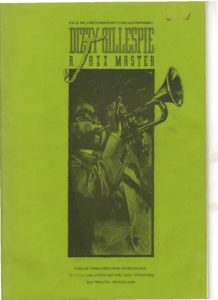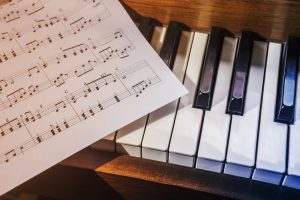Table of Contents
Remembering Dizzy Gillespie (1917-1993)

John Birks “Dizzy” Gillespie (short biography)
1982 NEA Jazz Master
Cheraw, South Carolina
Date of birth: Oct 21, 1917
Date of death: Jan 06, 1993
Trumpeter, Composer, Bandleader
The effect of John Birks ‘Dizzy’ Gillespie on jazz cannot be underestimated: his trumpet playing influenced all the musicians who came after him, his compositions have become part of the jazz canon, and his bands have included some of the biggest names in the business. He was also, along with Charlie Parker, one of the main leaders of the bebop movement.
Please, subscribe to our Library.
If you are already a subscriber, please, check our NEW SCORES’ page every month for new sheet music. THANK YOU!
Gillespie’s father was an amateur conductor who, although he died when Gillespie was ten, had given his son some of his early musical foundations. Gillespie began playing trumpet at age 14 after briefly trying the trombone, and his first formal musical training came at the Laurinburg Institute in North Carolina.
Gillespie’s first professional jobs were with the band Frankie Fairfax, where he reportedly adopted the nickname Dizzy due to his outlandish antics. His first influence was Roy Eldridge, whom he later replaced in Teddy Hill’s band. From 1939 to 1941, Gillespie was one of the principal soloists in Cab Calloway’s band, until he was fired for a notorious bandstand prank.
While with Calloway he met the Cuban trumpeter Mario Bauza, from whom he acquired a great interest in Afro-Cuban rhythms. Around this time he also became friends with Charlie Parker, with whom he would begin to develop some of the ideas behind bebop while sitting at Minton’s Playhouse in Harlem.
From 1941 to 1943, Gillespie freelanced with several big bands, including Earl ‘Fatha’ Hines. Hines’ band contained several musicians with whom Gillespie would interact in the development of bebop, such as singer Billy Eckstine, who formed his own band with Gillespie on trumpet in 1944.
The year 1945 was decisive for both bebop and Gillespie. He recorded with Parker many of his small hits, such as ‘Salt Peanuts’, and formed his own bebop big band. Despite financial problems, he was able to keep this band together for four years. His trumpet playing was at its peak, with rapid attacks of notes and an astonishing harmonic range.

Best Sheet Music download from our Library.
Several future greats performed with Gillespie’s big band, including saxophonists Gene Ammons, Yusef Lateef, Paul Gonsalves, Jimmy Heath, James Moody and John Coltrane. The rhythm section of John Lewis, Milt Jackson, Kenny Clarke and Ray Brown became the original Modern Jazz Quartet.
He took several bands on State Department tours around the world beginning in 1956, the first time the U.S. government provided financial aid and recognition to jazz. Those excursions not only kept Gillespie working, but also stimulated his musical interests as he began to incorporate different ethnic elements into his music, such as the Afro-Cuban rhythms that he wove into his big band arrangements. Never losing his thirst for collaboration, Gillespie worked with a variety of jazz stars and led his own small groups into the 1980s.
Selected Discography
The Complete RCA Victor Recordings 1937-1949, Bluebird, 1937-49
Dizzy’s Diamonds, Verve, 1954-64
Birk’s Works: Verve Big Band Sessions, Verve, 1956-57
Gillespiana/Carnegie Hall Concert, Verve, 1960-61
Max + Dizzy, Paris 1989, A&M, 1989

The Best of Dizzy Gillespie – Dizzy Gillespie Greatest Hits Full Album
Browse in the Library:
Or browse in the categories menus & download the Library Catalog PDF:
